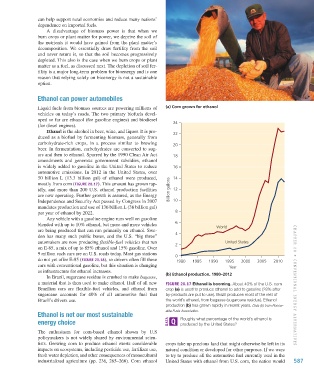Page 588 - Environment: The Science Behind the Stories
P. 588
can help support rural economies and reduce many nations’
dependence on imported fuels.
A disadvantage of biomass power is that when we
burn crops or plant matter for power, we deprive the soil of
the nutrients it would have gained from the plant matter’s
decomposition. We essentially draw fertility from the soil
and never return it, so that the soil becomes progressively
depleted. This also is the case when we burn crops or plant
matter as a fuel, as discussed next. The depletion of soil fer-
tility is a major long-term problem for bioenergy and is one
reason that relying solely on bioenergy is not a sustainable
option.
Ethanol can power automobiles
Liquid fuels from biomass sources are powering millions of (a) Corn grown for ethanol
vehicles on today’s roads. The two primary biofuels devel-
oped so far are ethanol (for gasoline engines) and biodiesel
(for diesel engines). 24
Ethanol is the alcohol in beer, wine, and liquor. It is pro- 22
duced as a biofuel by fermenting biomass, generally from
carbohydrate-rich crops, in a process similar to brewing 20
beer. In fermentation, carbohydrates are converted to sug-
ars and then to ethanol. Spurred by the 1990 Clean Air Act 18
amendments and generous government subsidies, ethanol
is widely added to gasoline in the United States to reduce 16
automotive emissions. In 2012 in the United States, over
50 billion L (13.3 billion gal) of ethanol were produced, 14
mostly from corn (FIGURE 20.17). This amount has grown rap-
idly, and more than 200 U.S. ethanol production facilities Billion gallons 12
are now operating. Further growth is assured, as the Energy
Independence and Security Act passed by Congress in 2007 10
mandates production and use of 136 billion L (36 billion gal)
per year of ethanol by 2022. 8
Any vehicle with a gasoline engine runs well on gasoline
blended with up to 10% ethanol, but more and more vehicles 6 World
are being produced that can run primarily on ethanol. Swe-
den has many such public buses, and the U.S. “big three” 4
automakers are now producing flexible-fuel vehicles that run 2 United States
on E-85, a mix of up to 85% ethanol and 15% gasoline. Over
9 million such cars are on U.S. roads today. Most gas stations 0
do not yet offer E-85 (FIGURE 20.18), so drivers often fill these 1980 1985 1990 1995 2000 2005 2010
cars with conventional gasoline, but this situation is changing Year
as infrastructure for ethanol increases.
In Brazil, sugarcane residue is crushed to make bagasse, (b) Ethanol production, 1980–2012
a material that is then used to make ethanol. Half of all new FIGURE 20.17 Ethanol is booming. About 40% of the U.S. corn CHAPTER 20 • CONVENTI ON AL ENERGY ALTERN ATIVES
Brazilian cars are flexible-fuel vehicles, and ethanol from crop (a) is used to produce ethanol to add to gasoline (28% after
sugarcane accounts for 40% of all automotive fuel that by-products are put to use). Brazil produces most of the rest of
Brazil’s drivers use. the world’s ethanol, from bagasse (sugarcane residue). Ethanol
production (b) has grown rapidly in recent years. Data (b) from Renew-
Ethanol is not our most sustainable able Fuels Association.
energy choice Roughly what percentage of the world’s ethanol is
produced by the United States?
The enthusiasm for corn-based ethanol shown by U.S
policymakers is not widely shared by environmental scien-
tists. Growing corn to produce ethanol exerts considerable crops take up precious land that might otherwise be left in its
impacts on ecosystems, including pesticide use, fertilizer use, natural condition or developed for other purposes. If we were
fresh water depletion, and other consequences of monocultural to try to produce all the automotive fuel currently used in the
industrialized agriculture (pp. 236, 265–266). Corn ethanol United States with ethanol from U.S. corn, the nation would 587
M20_WITH7428_05_SE_C20.indd 587 13/12/14 1:56 PM

